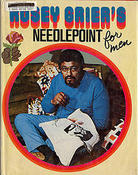
The working title is “Sex and Unisex: The Unfinished Business of the 1970s”. Because it’s clear to me from today’s culture wars that the sexual revolution is turning out to be more like the 100 Years War.
|
I am nearly finished with the proposal for the next book, on unisex trends from the late 1960s through the mid-1980s. Thanks to the fashion cycle and “That Seventies Show”, the superficial outlines of these trends are fairly familiar to the general public. As usual, my intent is to reveal how complicated the movement was (and I chose that word intentionally.).  The unisex movement – which includes female firefighters, Roosevelt Greer’s needlepoint and “Free to be…You and me” -- was a reaction to the restrictions of rigid concepts of sex and gender roles. Unisex clothing was a manifestation of the multitude of possible alternatives to gender binaries in everyday life. To reduce the unisex era to long hair vs. short hair, skirts vs. pants and yes, pink vs. blue is to perpetuate that binary and ignore the real creative pressure for alternatives that emerged during this period. But what alternatives were posed, and why? For the most part, unisex meant more masculine clothing for girls and women. Attempts to feminize men's appearance turned out to be short-lived, not permanent changes. The underlying argument in favor of rejecting gender binaries turns out to have been another binary: a forced decision between gender identities being a product of nature or nurture. For a while, the "nurture" side was winning. Gender roles were perceived to be socially constructed, learned patterns of behavior and therefore subject to review and revision. Unisex fashions were one front in the culture wars of the late 60s and 70s -- a war between people who believed that biology is destiny and those who believed that human agency could override DNA.
The working title is “Sex and Unisex: The Unfinished Business of the 1970s”. Because it’s clear to me from today’s culture wars that the sexual revolution is turning out to be more like the 100 Years War.
Cactus Wren
3/8/2012 09:33:21 pm
Wow, I'm looking forward to reading this one, and fully expect to enjoy it as much as I am "Pink and Blue"! I wonder whether the phenomenon you refer to here -- "unisex" equating to "girls and women in masculinized dress" -- isn't just another instance of male being the default, female the variation? As you point, it was hardly ever taken to mean "both men and woman, both boys and girls, dressing in an intermediate style": rather it seems to have meant girls and women dressing as *people* rather than as *women*. Traditionally masculine dress was the unsexualized, gender-neutral norm; traditionally feminine dress the sexualized, gender-specific variation.
Jo Paoletti
3/14/2012 04:36:44 am
I see three flavors of unisex clothing. Some ungendered styles are best described as “androgynous”, or combining elements of masculine and feminine styling. (flowered neckties for men.)The opposite approach to androgynous design is creating or appropriating neutral styles, devoid of masculine or feminine elements. (ponchos, dashikis and caftans) The third approach to unisex dressing is best termed “cross-dressing”, although I mean that term in a broader sense than is popularly meant. Most of the 70s designs I have seen so far are the latter, with the "crossing" limited to women adopting men's clothing.As you can see from my latest post, this fascinates me...
So
2/18/2014 06:04:42 am
Likewise, I really look forward your book and would love to see if this could have affected my own world when I grew up, because my gender identity is female yet I was born male bodied, and I liked both colours and played typically in a boyish and girlish way when I was small. Nature throws curved balls ;) Comments are closed.
|
Jo PaolettiProfessor Emerita Archives
January 2023
Categories
All
|